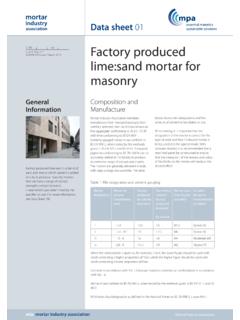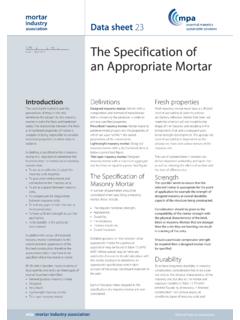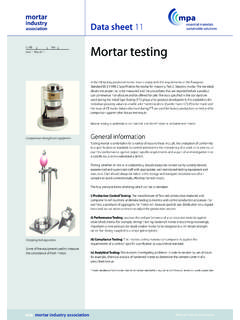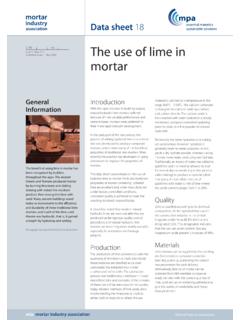Transcription of Issue 4 May 2012 F Efflorescence and bloom on …
1 Mia mortar industry associationMineral Products AssociationEfflorescence andbloom on masonryThe weather and condition of the materialscan also affect this problem. The wetter thebrickwork and mortar the greater the laitenceand hence the lighter the and fine aggregate (historically calledsand) containing foreign matter, such aspyrites and lignite, can cause staining asweathering building materials contain water solublesalts and with the water used in constructionthese salts will pass into solution andsubsequently reappear at, or near the surfaceas the building dries out. This form ofefflorescence seldom persists unless water ispermitted to percolate through the brickworkand it will normally disappear under theeffect of rain within a short period of salts responsible for efflorescencedepend on the particular building materialsused, although contamination from othersources should not be containing cement can becomecovered with a thin surface layer ofcarbonated material, derived from the freelime present in all types of cement effect may be seen where non-pigmented mortars are used but as the layerhere approximates more closely to the jointcolour, it is not usually considered a problemand indeed, is seldom noticed.
2 The effectmay be more pronounced where darkershades of pigmented mortars are carried out to investigate therelationship between the mortar used, thedesign of features and the degree of staining,showed that there was negligible differencebetween the use of lime:sand mortars andnon-lime based mortars . Detailing was foundFailure to recognise these two items will leadto unsightly brickwork which will not beimproved by age and is only partially rectifiedby the cleaning of the the best results: pay adequate attention in the design stage; use factory produced mortar for consistency; select the correct factory produced mortar; use products supplied by a Mortar IndustryAssociation producer member; adhere to good site practices and main causes of unsightly masonry are: constructional blemishes; Efflorescence ; is easy to identify constructional blemishesbut Efflorescence and bloom are chief cause of this is marking of thebricks with mortar, and this is particularlyapparent when a contrasting colouredmortar has been used.
3 Other foreign matterdeposited on brickwork during constructionwill also disfigure it and will probably bedifficult to factor that may spoil the appearanceof brickwork is the band effect seen on manywalls. It can be caused by variations in shadesof different brick deliveries. The type of jointcan also cause this and it is morepronounced when the joints are ironing of the joint brings laitence to thesurface. If the mortar consistence varies thenwhen ironed so does the degree of appearance of a building isenhanced by good quality centuries of weathering, claybrickwork still has an attractiveappearance. This can only be achievedif emphasis is placed on good detailingat the design stage followed by 4 May 2012(SUPERSEDESI ssue 3 January 2005)CI/SfB(G1)Data sheet08 There is a real danger of contact dermatitis orserious burns if skin comes into contact withwet mortar.
4 Wear suitable protective clothingand eye protection. Where skin contact occurseither directly or through saturated clothingwash immediately with soap and water. For eyecontact immediately wash out eyes thoroughlywith clean water. If swallowed wash out mouthand drink plenty of water. The relevant codes of practice, standards andstatutory regulations must always be information in this data sheet may be freelycopied with acknowledgement to the MortarIndustry association . Current Issue numbers ofall MIA publications are available from the Mortar industry association is part of theMineral Products association , the tradeassociation for the aggregates, asphalt,cement, concrete, dimension stone, lime,mortar and silica sand industriesMineral Products association LtdGillingham House 38 - 44 Gillingham StreetLondon SW1V 1 HUTel +44 (0)20 7963 8000 Fax +44 (0)20 7963 Mineral Products association 2012to be the overriding factor, correctly detailedmasonry exhibited a complete lack ofstaining thus proving the importance ofcorrect detailing when designing a ActionThe causes of constructional blemishes, Efflorescence and bloom have beendiscussed, but how are they overcome?
5 1 Design and plan wellAttention must be paid to design features, especially parapet walls, sills, copings etc. Water must not be allowed to percolate into masonry and keep it in a damp ActionEfflorescence, unless caused by permanentdampness, should weather away and doesnot cause permanent with a stiff brush when dry is thebest method of removal. The removal ofconstruction blemishes and bloom can beeffected to some degree by treatment withproprietary materials or diluted hydrochloricacid. Before attempting such remedial work,however, always experiment with a small trialarea and consult the brick manufacturer. ALWAYS OBSERVE FULL HEALTHAND SAFETY PRECAUTIONS ANDWEAR GOGGLES AND Select the correct mortarUse a factory produced mortar, supplied by a Mortar industry association producer member, to produce the most durable, defect-free Site care and workmanship Water on a building site is both friend and foe.
6 It is necessary to ensure hydration of cement, gypsum etc., but excess can causemany problems such as Efflorescence , drying shrinkage, should cover materials on site both before and after erection. In the case of walling materials, this will help to reduceefflorescence and bloom . Care of materials should lead to good workmanship and thiswill reduce constructional blemishes. CARE DURING CONSTRUCTION WILL SAVE MONEY IN THE 5642 - 1 Sills and copings. Specification for copings of precast concrete, cast stone, clayware, slate and natural stoneBS 8221 Code of practice for cleaning and surface repair of buildingsPart 1: Cleaning of natural stones, bricks, terracotta and concretePart 2: Surface repair of natural stones, bricks and terracottaRitchie, T:Study of Efflorescence produced on ceramic wicks by masonry mortars , Journal of the American Ceramic Society 38, 362 - 366 ReferencesFor a full list of British and European Standards see the MIA data sheet of technical references.











